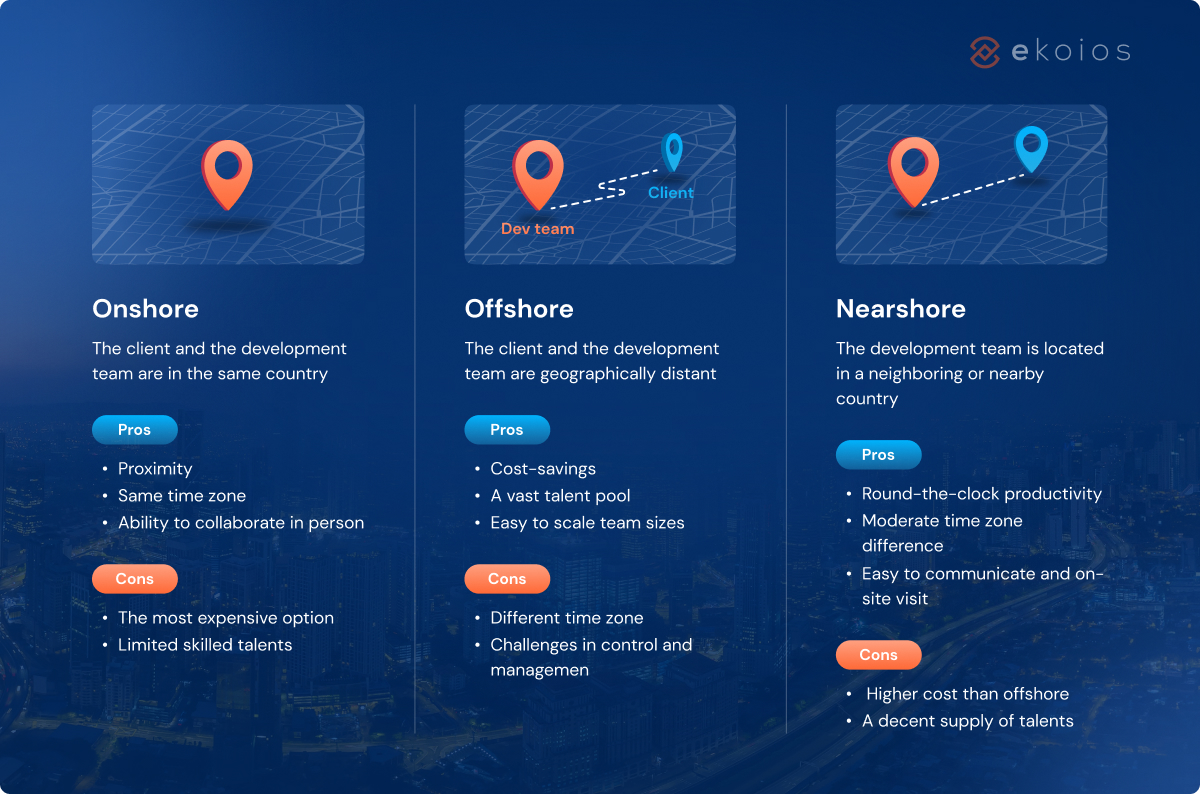
- 1
- 2
- 3
- 4
- 5
In the fast-paced economy, businesses are increasingly turning to outsourcing as a strategic approach to meet their software development needs. Onshore, offshore, and nearshore outsourcing are three popular location-based models that offer distinct advantages and considerations. Today, we will explore the differences between these outsourcing models and guide you in choosing the most suitable options for your needs.
Onshore, offshore and nearshore definition
 1. Onshore software development
1. Onshore software development
Onshore outsourcing refers to hiring a software development team within the same country as the client’s business. For example, if a US-based company contracts with a software development firm located in the US, it is considered onshore outsourcing.
The benefits of onshore outsourcing are significant:
- Proximity and ease of communication: The proximity between the client and the development team allows for face-to-face meetings, regular on-site visits, and direct communication channels. Being in the same time zone facilitates real-time collaboration and seamless communication, which can greatly enhance the efficiency of the development process.
- Cultural alignment: A high level of cultural alignment between the client and the development team contributes to smooth collaboration and understanding. It minimizes the chances of miscommunication, reduces cultural barriers, and fosters a stronger working relationship.
- Quality and standards: Onshore outsourcing teams operating within the same country as the client are more likely to be familiar with local business practices, regulations, and customer expectations, resulting in higher-quality deliverables.
However, onshore software development might come with some disadvantages:
- The most expensive option: Since onshore outsourcing happens within the same country or geographical region as the client, labor costs tend to be higher due to factors such as higher wages, taxes, and living expenses in developed countries.
- Limited skilled talents: The availability of skilled professionals may vary depending on the local market conditions and competition for talent within the same region, leading to challenges in hiring professionals with the required expertise. This can impact the quality of project execution.
2. Offshore software development
It involves hiring a development team from a different country, often one with a significant cost advantage. The client and the development team are geographically distant and may have different cultural backgrounds and time zones. For instance, a European company might choose to outsource to a team located in Vietnam, China or India.
There are 3 outstanding benefits of offshore outsourcing:
- Cost savings: Outsourcing to countries in Asia with lower labor costs, such as Vietnam, India, or the Philippines, offer significant cost savings compared to hiring local resources. The cost per hour in those countries ranges from $20-$50, saving you up to 50% of your budget in comparison to the US or European countries. Businesses can allocate their budget more effectively, especially for large-scale projects or long-term partnerships. Besides, you need to consider other factors influencing software development costs like tech stacks, platforms or project scopes to prepare a proper budget.
- Access to skilled talent: Countries known for their expertise in software development, like Vietnam, India or Eastern European nations, often have a large number of highly qualified developers. Businesses can tap into specialized skills and domain expertise that may not be available locally.
- Scalability and flexibility: The offshore outsourcing model offers scalability and flexibility in resource allocation. Businesses can quickly scale their development teams up or down based on project requirements, without the need for extensive recruitment or downsizing processes.
Offshore software development poses some barriers:
- Different time zones: Collaboration and communication can be affected by the time lag, leading to delays in communication and decision-making, as teams may have limited overlapping working hours. This can potentially slow down the
- Control and management: Effective control and management of an offshore team require robust project management practices and regular reporting. The client must set up clear guidelines, provide detailed documentation, and maintain regular communication to minimize the risk of misinterpretation.
3. Nearshore software development
Nearshore outsourcing combines the best of both worlds. The software development team is located in a neighboring or nearby country. A US-based company might choose to outsource to a team in Mexico or Canada.
The benefits of nearshore software development include:
- Cost savings with proximity: While nearshore outsourcing may not offer the same cost advantages as offshore outsourcing, it can still provide cost savings compared to onshore outsourcing. The proximity of the development team reduces travel costs, minimizes time zone-related inefficiencies, and allows for more cost-effective coordination and project management.
- Enhanced productivity: By leveraging minimal time zone differences, while the client’s team rests, the nearshore team can continue working, providing extended work hours and faster turnaround times. This can be advantageous for time-sensitive projects or when tight deadlines need to be met.
- Reduced communication challenges: Nearshore outsourcing can minimize language and communication challenges compared to offshore outsourcing. Although there may still be some language differences, neighboring countries often have higher language proficiency levels and cultural similarities, making communication smoother, reducing the chances of miscommunication and ensuring clearer project requirements.
While nearshore outsourcing offers advantages in terms of proximity and cultural alignment, it is essential to consider the higher cost compared to offshore options and assess the availability of specialized talents within the nearby region.
- High cost: Nearshore outsourcing is generally more expensive than offshore outsourcing. The higher cost can be a limiting factor for organizations with stricter budget constraints or cost-sensitive projects.
- A decent supply of talent: While nearby countries may offer a larger talent pool compared to the client’s local market, it may not be as extensive as the global talent pool accessible through offshore outsourcing. Organizations with specific technology requirements or seeking rare expertise may find it difficult to locate suitable professionals within the nearby region.
Onshore, offshore and nearshore comparison
When considering onshore, offshore, and nearshore software development options, several factors need to be compared. Here is a detailed comparison based on the following factors: cost, time differences, cultural alignment, expertise, and talent pool.
Table 1: The differences between onshore, offshore and nearshore
| Factors | Onshore | Offshore | Nearshore |
|---|---|---|---|
| Cost | The highest cost | The lowest cost | Higher cost than offshore |
| Time differences | Minimal to no differences | Significant differences | Moderate differences |
| Cultural alignment | The highest level of alignment | The lowest level of alignment | Higher level of alignment than offshore |
| Expertise | Easy access to local expertise | Diversity of expertise and skills | A balance between onshore and offshore |
| Talent pool | A small pool of availability and specialization | A large pool of developers and engineers | A decent pool of skilled professionals |
📌Read more: The differences between IT outsourcing models
Navigate through your right selection: Onshore, offshore and nearshore
Once you have an understanding of the differences among onshore, offshore and nearshore outsourcing models, let’s look at how to select the right one. Choosing the right software development team is a critical decision for any organization considering outsourcing.
Onshore software development is favored when effective communication, cultural alignment, and control play pivotal roles in the project’s success. This approach is particularly suitable for projects that necessitate close collaboration and frequent communication between the client and the development team. It is also ideal for sensitive projects that require strict adherence to legal frameworks within the client’s country. Additionally, clients who prefer direct control over the development process often opt for onshore outsourcing.
In contrast, offshore software development is preferred primarily for its cost-saving advantages. Organizations looking to tap into a vast talent pool with diverse skills and expertise would choose this model. Furthermore, flexible projects find offshore outsourcing to be a beneficial option since the client can scale the project scopes, and team sizes up or down.
📌More tips on cost-saving when outsourcing: Here
On the other hand, nearshore outsourcing is chosen when there is a need for a significant overlap in working hours between the client and the development team. It proves valuable for projects aiming to achieve cost savings without compromising on quality and efficient communication. Moreover, organizations seeking access to a broader talent pool beyond their local market find nearshore outsourcing advantageous.
📌Read more: Software outsourcing vendor evaluation
Vietnam as a preferred outsourcing destination
Vietnam has emerged as a sought-after outsourcing destination, attracting the attention of many companies.
Vietnam offers cost-effective solutions, making it an appealing outsourcing option for companies mindful of their budgets. The average hourly rate is $20-$40, saving up to 50$-70% of costs compared to the US, Europe, India and China. The country boasts a growing pool of highly skilled IT professionals in software development, QA/testing, and UX/UI design. Many Vietnamese developers have extensive experience working with international clients and possess proficiency in a wide range of technologies. In addition to technical expertise, Vietnamese IT professionals also excel in languages like English or Japanese.
The Vietnamese government actively supports the development of the IT industry by applying tax incentives policy to tech-related businesses. With a stable GDP growth of 6-7% in recent years, Vietnam expects to be among the top 30 in the Digital Infrastructure Development Index by 2030, focusing on 5G, data center, cloud computing and digital technology.
📌Read more: Why Vietnam Is The Go-to Destination?
Collaborate with Ekotek Technology
When it comes to outsourcing, finding the right IT partner is crucial for unlocking value and achieving success. In this regard, Ekotek Technology stands out as a suitable outsourcing vendor for your projects. We provide both nearshore and offshore IT outsourcing services to cater to the specific needs of clients. With extensive IT experience and a highly skilled team of over 180 tech specialists who are proficient in both English and Japanese, we have the expertise needed to drive your projects forward.
Our commitment to active and frequent communication minimizes the challenges associated with nearshore and offshore outsourcing. We prioritize clear and transparent communication channels to keep clients always up to date on the project’s progress.
Ekotek is based in Vietnam and offers competitive pricing while delivering high-quality results. We have built a strong track record in the software development industry, web and mobile app, blockchain and AI development, and worked with a diverse range of clients, including startups and enterprises worldwide. Our talented staff extends across various domains, from UX/UI designers, and front-end and back-end developers to DevOps engineers, and QA and testing specialists, ensuring that they can meet the unique requirements of your business.
By partnering with Ekotek, you can have the confidence that your projects will be handled by capable hands. Don’t wait any longer, embark on a journey of success by scheduling a free consultation with us today
- 1
- 2
- 3
- 4
- 5